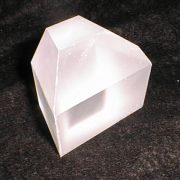|
Standard B-style assemblies SCIONIX scintillation detectors are characterized by a type number in which most of the properties of the instrument can be found. However, there remain features that are not “captured” in the type number (e.g. special geometries or electronic features) since there is an large number of ways a scintillation detector can be constructed. In this case the suffix -Xxx is added to the type number which refers to “special”. Note that for some of the nine features below, more than one option may apply. The following example, type number V 50 BD 5 / 2 M – E1 – CS – X indicates a 50 mm square CsI(Tl) crystal, 5 mm high, integrally coupled to a 51 mm diameter (2″) photomultiplier tube. The detector is provided with a beryllium entrance window, solid Mu-metal detector housing and built-in voltage divider. It is a customer special. |
Nomenclature & Type numbering


1. Geometry of scintillator
V = Square
R = Rectangular
C = Spherical
Z = Hexagonal
– = Cylindrical (default)
Actual scintillation diameter in mm
3. Type of crystal / light detector coupling
A = Demountable light detector
B = Integrally mounted light detector
C = Crystal without light detector
K = Gamma camera crystal
P = Photodiode readout
T = High temperature detector
H = Crystal readout side perpendicular to PMT
F = Fiber optics light guide
Q = Quartz light guide or window
4. Type of window / housing
A = Thin window aluminum entrance window
D = Beryllium entrance window
M = Mylar entrance window
S = Stainless Steel housing
C = Copper housing/window
CF = Carbon Fiber window
P = Axial well in crystal
R = Ruggedized construction
– = Standard 0.5 mm thick aluminum housing (default)
5. Height of crystal in mm
In case of phoswiches, the height of the primary crystal precedes the letters PH followed by the height of the secondary (guard) crystal.
6. Size and Quantity of the light detector
When the readout is with a photomultiplier (PMT) the number here is the diameter of the PMT in inches. In case of more than one PMT, the number is indicated in brackets after the diameter; e.g. / 3(3) indicates three 76 mm PMTs
When the readout is with a silicon photomultiplier (SiPm), the type number shows here “SiP“ with in brackets the number of SiPm modules.
In case of photodiode readout, the size of the photodiode is indicated in mm.
7. Electronics/ features of PMT
M = External solid μ-metal shield
E1 = Built-in Voltage Divider (VD)
E2 = Voltage divider / preamplifier
E3 = Special electronics module
Es = SiPm resistor / capacitors
HV = Built-in high voltage generator
-NEG = Negative high voltage operation (standard is positive)
8. Scintillation material
BGO = BGO
BAF = BaF2
CaF = CaF2 (Eu)
CEBR = CeBr3
CLYC = CLYC:Ce
CN = CsI(Na)
CS = CsI(Tl)
LBC = Lanthanum BromoChloride
LYSO = LYSO
P = Plastic scintillator (general) or the specific type
SRI = SrI2(Eu)
YAP = YAP:Ce
ZnS = ZnS(Ag)
– = NaI(Tl)
NOTE; frequently new materials are added to the list ; SCIONIX offers all scintillation materials that are commerciallly available
9 Extra features
Am = Am light pulser
T = Built-in thermistor
O = Fiber optic for gain monitoring PMT
L = Built-in LED
Xxx = Non standard or custom configuration
LB = Special low background selected materials
Standard “off the shelf” scintillation detectors are provided with silver anodized aluminum housings, bialkali photocathode PMTs and positive (+) high voltage operation.


